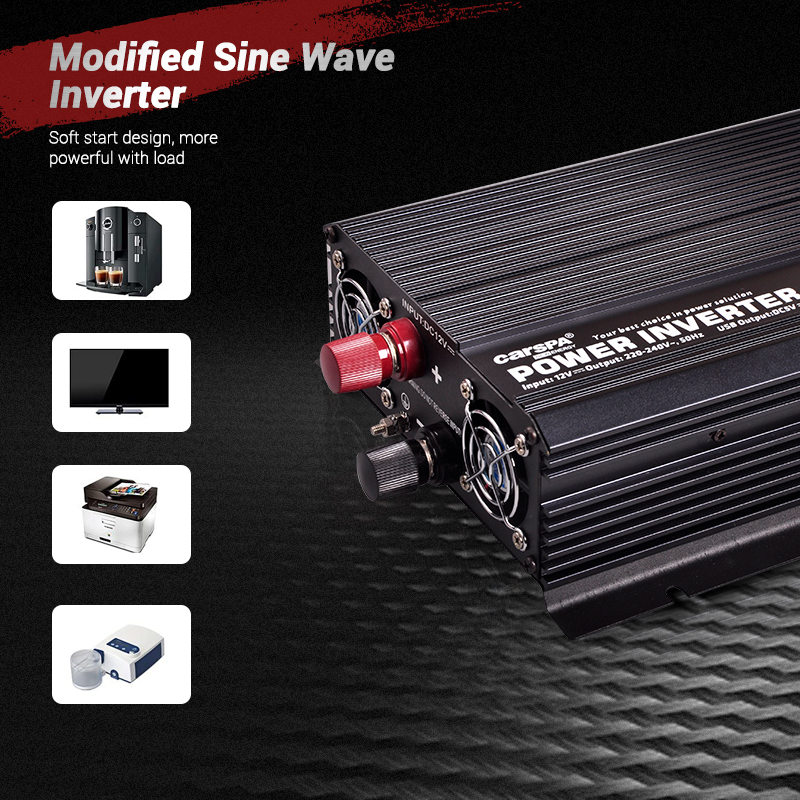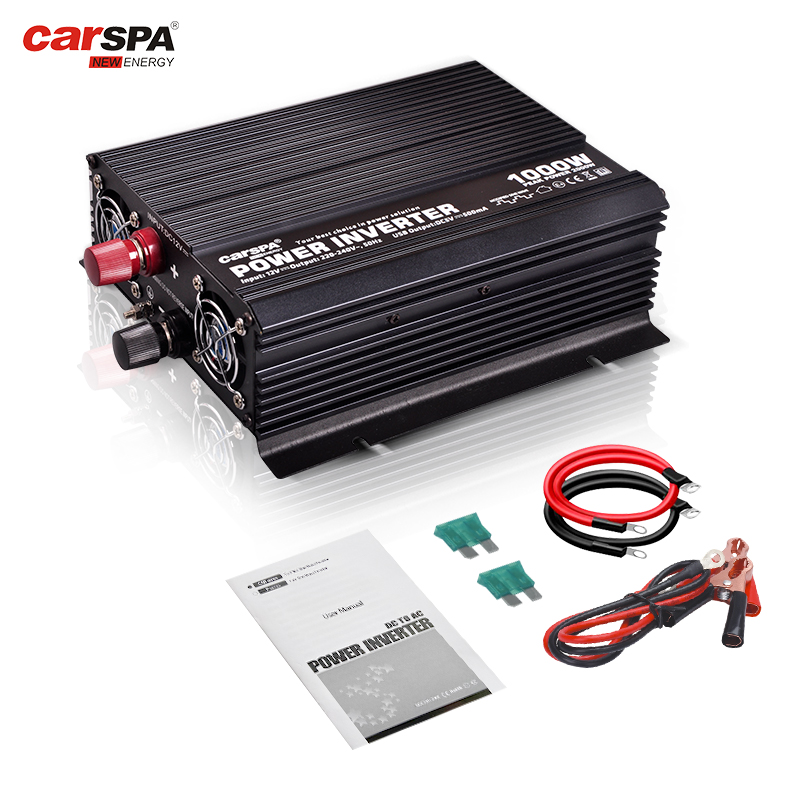Can a 1000W inverter charge a 200Ah battery and How long can it charge?
In daily life, especially in off-grid applications and emergency power supply systems, the combination of batteries and inverters is often used to provide stable power output. However, when it comes to charging the battery, the inverter's capabilities and charging speed become key factors. So, can a 1000W power inverter charge a 200Ah battery? If so, how long does it take to fully charge the battery? This article will explore this question in detail and answer many aspects related to it.
1. Can a 1000W power inverter charge a 200Ah battery?
2. How long does it take to fully charge a 200Ah battery?
3. What issues should be paid attention to during charging?
4. Suggestions for practical application
1. Can a 1000W power inverter charge a 200Ah battery?
Before answering this question, we first need to understand the basic functions and working principles of the inverter. The main function of the inverter is to convert direct current (DC) into alternating current (AC) for powering household appliances or other devices. Normally, the inverter is not directly responsible for charging the battery, but the charger is responsible for charging. However, some inverters have charging functions built into their designs, allowing them to both convert current and reversely charge the battery.
The difference between inverter and charger
Although both inverter and charger are used in off-grid systems, their functions are different:
Inverter: The main function of the inverter is to convert the DC power of the battery into AC power and supply power to the equipment.
Charger: The charger converts AC power into DC power and provides appropriate voltage and current according to the needs of the battery to store the power in the battery.
Therefore, if only a 1000 watt power inverter is used and the inverter does not have a built-in charging function, it cannot charge the battery. However, if the inverter has a built-in charging module or is connected to an external charger, the inverter can charge the battery through the charger.
Charging mode of inverter
Some inverter products (especially high-end models) have dual functions of charging and inverter. They can convert AC power into DC power when connected to an external power source to charge the battery. This type of inverter uses the power supply to charge the battery when the mains power is normal. When the mains power is interrupted, it automatically switches to inverter mode and obtains DC power from the battery to power the device.
Take a 1000W inverter as an example. If it has a charging function and the current of the charger module is suitable for a 200Ah battery, then theoretically it can charge a 200Ah battery.
2. How long does it take to fully charge a 200Ah battery?
To determine how long it takes to charge a 200Ah battery, we need to understand several important parameters: the capacity of the battery, the charging current, and the efficiency of the charger.
Basic concept of battery capacity
A 200Ah battery means that it can provide a current of 200 amperes in 1 hour, or continuously discharge at a current of 10 amperes in 20 hours. When charging, the relationship between the battery capacity and the charging current determines the charging time. The charging time is calculated as follows:
Charging time = battery capacity (Ah) / charging current (A)
For example, if the charging current is 20A, then the time to fully charge a 200Ah battery is:
Charging time = 200Ah/20A = 10 hours
However, the actual charging time may be affected by the efficiency of the charger, the ambient temperature, and the battery status. Usually, the efficiency of the charger will not be 100%, so we also need to consider the energy loss during the charging process.
Charger efficiency
Energy loss is inevitable during the charging process. Usually, the efficiency of the charger is between 85%-95%, which means that part of the electrical energy will be lost as heat during the conversion process. Therefore, the actual calculation of charging time should include the factor of charger efficiency:
Actual charging time = battery capacity (Ah)/(charging current (A)×charger efficiency (%))
Assuming the efficiency of the charger is 90% and the charging current is 20A, the actual charging time is:
Actual charging time = 200Ah/(20A×0.90)≈11.1 hours
Effect of different charging currents on charging time
The size of the charging current directly determines the charging time. Generally speaking, battery manufacturers will recommend an optimal charging current to ensure the safety and life of the battery. Too high a charging current may cause the battery to overheat and shorten the battery life; too low a charging current will prolong the charging time and reduce the charging efficiency.
Taking a 200Ah battery as an example, if the charging current is 10A, the time required for full charging will double:
Charging time = 200Ah/(10A×0.90)≈22.2 hours
On the contrary, if the charging current is increased to 30A, the charging time will be reduced accordingly:
Charging time = 200Ah/(30A×0.90)≈7.4 hours
Therefore, in practical applications, it is very important to choose a suitable charging current, which not only affects the charging time, but also the health of the battery.
3. What issues should be paid attention to during charging?
To ensure the safety and efficiency of battery charging, there are several key issues that need special attention during the charging process.
Avoid overcharging
Overcharging is one of the main causes of battery damage. Overcharging can accelerate the chemical reaction inside the battery, generate excessive heat, and then cause the battery to swell, leak or even catch fire. Therefore, the charging function of the inverter or the external charger should have automatic power-off or intelligent management functions to automatically stop charging when the battery is fully charged.
To avoid overcharging, modern chargers are usually equipped with intelligent charging management systems that monitor the battery voltage and current and automatically switch to floating charge mode when the battery is close to full, maintaining the battery charge with a small current.
Charging temperature management
During the charging process, both the battery and the charger will generate heat. Excessive temperature may cause the battery performance to deteriorate or even damage. Therefore, when charging, you should ensure that the ambient temperature is suitable and avoid charging under high or extremely low temperature conditions.
Many modern chargers are equipped with temperature sensors that can monitor the battery temperature in real time and adjust the charging current according to the temperature conditions to ensure the safety of the charging process. In addition, a well-ventilated environment can also help reduce the temperature rise during charging.
Battery health status
The health status of the battery has a great impact on the charging process. Aging or damaged batteries may experience voltage instability and slow charging speed when charging. Therefore, it is very necessary to check the battery status and perform maintenance regularly.
For example, after a lead-acid battery is used for a long time, its internal electrolyte may evaporate and replenishing fluid needs to be added regularly. At the same time, the battery plates may also produce sulfation due to the charge and discharge cycle, affecting the battery capacity and charging efficiency.
4. Suggestions for practical application
Through the above analysis, we can see that if a 1000W RV inverter has a charging function, it can theoretically charge a 200Ah battery, but the charging time will be affected by the charging current and the efficiency of the charger. In practical applications, we recommend choosing a suitable charger and adjusting the charging strategy according to the capacity and health status of the battery.
Choose the right inverter and charger
If you plan to use a 1000W power inverter to charge a 200Ah battery, make sure the inverter is equipped with a built-in charging function or is used with a suitable charger. At the same time, the charger current should match the capacity of the battery to avoid excessive or low charging current.
Regularly maintain the battery
The health status of the battery has an important impact on the charging efficiency and charging time. Regularly maintaining the battery, including checking the electrolyte, cleaning the battery extremes, and avoiding deep discharge, can extend the battery life and improve the charging efficiency.
Pay attention to the charging environment
To ensure the safety of charging, the ambient temperature should be moderate during charging, and the charger and battery should be placed in a well-ventilated place to prevent overheating. In addition, check the working status of the charger and inverter regularly to ensure their normal operation.
Conclusion
A 1000-watt power inverter can theoretically charge a 200Ah battery, but the premise is that the inverter has a charging function or is used with an external charger. The charging time depends on the charging current, the efficiency of the charger, and the health of the battery. In practical applications, in order to ensure the safety and efficiency of charging, it is recommended to choose a suitable charger, regularly maintain the battery, and pay attention to the charging environment. Through correct use and management, the long-term stable operation of the battery can be ensured, providing reliable power support for various off-grid applications.








